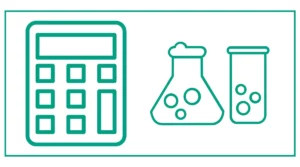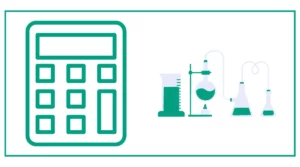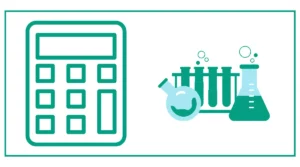Delta g Calculator (Gibbs Free Energy)
The Delta g Calculator helps you calculate the Gibbs free energy very easily.
Enter the temperature (T), and changes in enthalpy (ΔH) and entropy (ΔS) to determine the Gibbs free energy.
In case you don’t know, Gibbs free energy, symbolized as G, is the product of enthalpy and entropy.
The free energy change (G) is equal to the enthalpy change plus the product of the temperature and entropy change.
ΔG° = ΔH° – TΔS°

You might want to determine the Equilibrium constant or Charles’s final volume.
What is Gibbs Free Energy?
Gibbs free energy, often denoted as G, is a thermodynamic quantity that combines enthalpy and entropy to determine the maximum amount of useful work that can be obtained from a system. It is typically used to predict whether a reaction will occur spontaneously under constant temperature and pressure conditions.
The equation for Gibbs free energy is:
ΔG = ΔH – TΔS
Where:
- ΔG is the change in Gibbs free energy
- ΔH is the change in enthalpy
- T is the temperature in Kelvin
- ΔS is the change in entropy
This equation shows that Gibbs free energy depends on both the enthalpy and entropy of a system, as well as the temperature at which the reaction occurs.
The Importance of Gibbs Free Energy in Chemistry
Gibbs free energy plays a crucial role in understanding chemical reactions and equilibrium states. Here are some key reasons why it’s important:
- Predicting Spontaneity: The sign of ΔG indicates whether a reaction is spontaneous or non-spontaneous under given conditions.
- Determining Equilibrium: When ΔG = 0, a system is at equilibrium.
- Calculating Maximum Work: Gibbs free energy represents the maximum amount of non-expansion work that can be extracted from a system.
- Understanding Reaction Feasibility: It helps in determining whether a reaction is thermodynamically favorable.
How to Use the Gibbs Free Energy Calculator
Our Gibbs free energy calculator is designed to be user-friendly and efficient. Follow these steps to calculate the Gibbs free energy for your chemical reaction:
- Enter the Change in Enthalpy (ΔH) in kilojoules (kJ).
- Input the Change in Entropy (ΔS) in kilojoules per Kelvin (kJ/K).
- Specify the Temperature (T) in Kelvin (K).
- Click the “Calculate” button.
The calculator will then determine the Gibbs free energy (ΔG) based on the provided values.
Interpreting the Results
After calculating the Gibbs free energy, it’s essential to understand what the result means:
- If ΔG < 0 (negative): The reaction is spontaneous at the given temperature.
- If ΔG = 0: The system is at equilibrium.
- If ΔG > 0 (positive): The reaction is non-spontaneous at the given temperature.
Remember that spontaneity doesn’t necessarily mean the reaction will occur quickly. It only indicates the thermodynamic favorability of the reaction.
Examples of Gibbs Free Energy Calculations
Let’s examine two examples to illustrate how the Gibbs free energy calculator can be used in practical scenarios:
Example 1: Synthesis of Ammonia
Consider the synthesis of ammonia (NH3) from nitrogen (N2) and hydrogen (H2):
N2 (g) + 3H2 (g) → 2NH3 (g)
Given:
- ΔH = -92.22 kJ/mol
- ΔS = -198.75 J/(mol·K)
- T = 298 K (room temperature)
Using our calculator:
- Enter ΔH: -92.22
- Enter ΔS: -0.19875 (converted to kJ/K)
- Enter T: 298
- Calculate
Result: ΔG ≈ -33.01 kJ/mol
Interpretation: The negative ΔG indicates that the formation of ammonia is spontaneous at room temperature.
Example 2: Melting of Ice
Now, let’s consider the melting of ice:
H2O (s) → H2O (l)
Given:
- ΔH = 6.01 kJ/mol
- ΔS = 22.1 J/(mol·K)
- T = 273 K (0°C, the melting point of water)
Using our calculator:
- Enter ΔH: 6.01
- Enter ΔS: 0.0221 (converted to kJ/K)
- Enter T: 273
- Calculate
Result: ΔG ≈ 0 kJ/mol
Interpretation: The ΔG value of approximately zero indicates that the system is at equilibrium, which is expected at the melting point of water.
Applications of Gibbs Free Energy
Understanding and calculating Gibbs free energy has numerous applications across various fields:
- Chemical Engineering: Optimizing reaction conditions and designing chemical processes.
- Biochemistry: Studying metabolic pathways and enzyme kinetics.
- Materials Science: Predicting phase transitions and material stability.
- Environmental Science: Analyzing pollutant behavior and environmental reactions.
- Pharmaceuticals: Drug design and understanding drug-target interactions.
Limitations and Considerations
While the Gibbs free energy calculator is a powerful tool, it’s important to be aware of its limitations:
- Constant Conditions: The equation assumes constant temperature and pressure.
- Ideal Systems: Real-world systems may deviate from ideal behavior.
- Kinetics Not Considered: The calculator doesn’t account for reaction rates or activation energy.
- Accuracy of Input Data: The results are only as accurate as the input values for ΔH and ΔS.





